
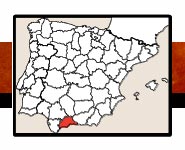

 |
 |
||
 |
|||
 |
(40)/L-P/MALA-malaga-40.jpg) |
-55/BOOK-cort-40.jpg) |
 |
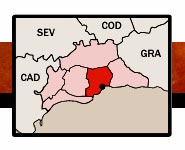 |
||
 |
|||
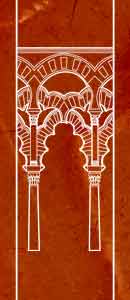 |
ACCEDER A MÁLAGAMálaga es una ciudad grande y acceder a la zona monumental es difícil, aconsejamos: Si vienes desde el interior (Sevilla, Granada, Córdoba o Madrid) por la A-45, seguir los letreros al centro de la ciudad, iremos paralelos al río Guadalmedina que desemboca en el puerto de Málaga. Si vienes desde Almería o Nerja cogeremos en la A-7 la salida 242 (Ciudad Jardín) todo recto hasta la segunda glorieta donde torceremos a la izquierda y bajaremos paralelos al rio Guadalmedina hasta el puerto. En ambos casos bajando el río el área monumental, está a izquierda. Si vienes por Algeciras o Marbella por la A-7 nos saldremos por la carretera “Málaga-Cartama” todo recto, dirección centro, cruzando el río Guadalmedina.UBICACIÓNTEATRO: Esta situado en la misma ladera ocupada por la alcazaba de Málaga, en la calle Alcazabilla. ALCAZABA: En un cerro en la ciudad de Málaga, en las proximidades del puerto y de la Plaza de Toros. CATEDRAL: En el casco histórico de Málaga . ACCESO PARA MINUSVÁLIDOSTEATRO: Hay una pasarela para visitar el teatro. ALCAZABA: Muchas cuestas, para sillas de ruedas. CATEDRAL: Acceso factible para sillas de ruedas (malagaturismo). |
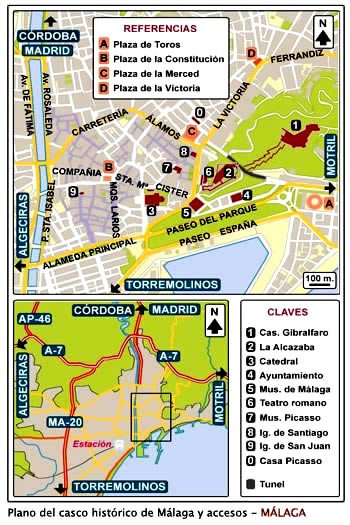 |
ACCESS TO MÁLAGAMálaga is a large city and access to monumental area can be difficult, we advise: If you come from the interior (Seville, Granada, Córdoba or Madrid) by the A-45, you must follow the sighpostes to the city center, we will go parallel to the river Guadalmedina that ends in the port of Málaga. If you come from Almería or Nerja take in the A-7 exit 242 (Ciudad Jardin) straight ahead until the second roundabout where we turn left and we will descend parallel to the Guadalmedina River. If you go down by the river the monumental area is on the left. If we come from Algeciras or Marbella by the A-7 we will take the road “Málaga-Cartama” go straight to the center, and crossing the Guadalmedina River. LOCATIONTHEATER: It is located on the same slope occupied by the Alcazaba of Málaga, in the Alcazabilla Street. ALCAZABA: Located on a hill in the city of Málaga, near the port and the Bullring. CATHEDRAL: In the historic center of Málaga. ACCESS FOR THE HANDICAPPEDTHEATER: There is a wall-way to visit the theater. ALCAZABA: There are many slopes, for wheelchairs. CATHEDRAL: Possible access for wheelchairs (malagaturismo). |
||||
 |
|||||||
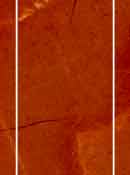 |